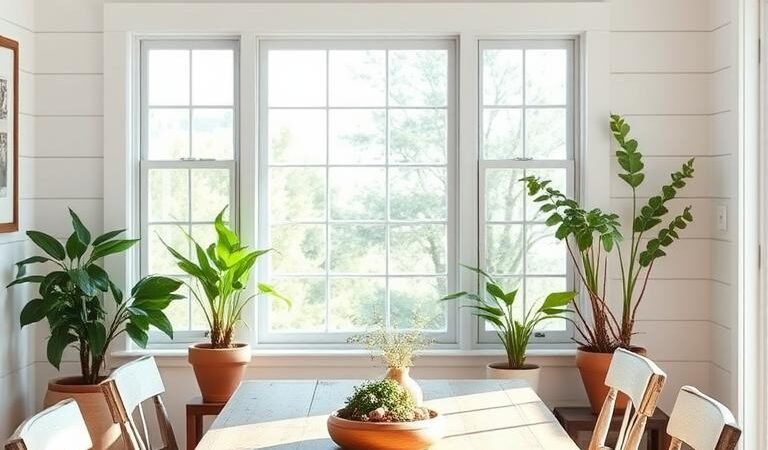The modern farmhouse aesthetic blends rustic charm with contemporary elegance, creating spaces that feel both cozy and stylish. Natural wood, neutral tones, and earthy textures form the foundation of this design approach. Thoughtful updates—like mixing reclaimed materials with sleek lighting—can transform any space into a welcoming gathering spot.
Leading designers, such as Amber Lewis and McGee & Co, emphasize balance in these spaces. A well-designed dining area combines functionality with visual appeal, offering room for meals and memories. Sustainable decor choices, like thrifted finds, add character while keeping the look fresh.
Whether refreshing a table or rethinking storage, small changes make a big impact. The key lies in harmonizing warmth with modern simplicity—a signature of farmhouse style.
Key Takeaways
- Modern farmhouse design blends rustic and contemporary elements.
- Neutral tones and natural textures create a timeless foundation.
- Functional storage enhances both style and practicality.
- Thrifted decor adds sustainable charm.
- Lighting and furniture mixing refresh the space effortlessly.
1. Start with a Neutral Color Palette
Designers like Amber Lewis prove neutral walls amplify natural textures and wood tones. A soft backdrop lets furniture and decor shine—whether it’s dark oak tables or woven baskets. The secret? Layering whites, grays, and earthy hues for depth.
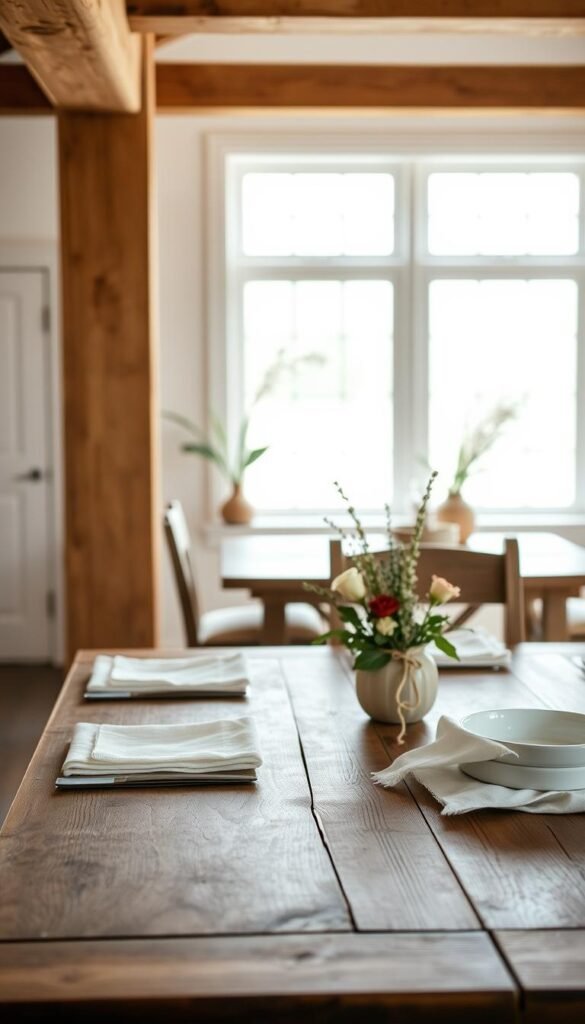
Earthy Tones for a Timeless Base
Benjamin Moore’s Swiss Coffee adds creamy warmth to walls, especially in sunlit spaces. Pair it with oak flooring or putty-gray accents for organic contrast. North-facing rooms benefit from Farrow & Ball’s Setting Plaster, a blush-neutral that glows in low light.
Soft Whites and Warm Grays to Enhance Light
Mindy Gayer’s white shiplap walls highlight textured furniture, while brass pendants add sparkle. For filtered sunlight, layer linen curtains in natural undyed shades. Jake Arnold’s trick? Dark wood tables against light backdrops create striking balance.
| Paint Color | Best For | Pairings |
|---|---|---|
| Swiss Coffee (Benjamin Moore) | Warm, creamy walls | Oak floors, black accents |
| Setting Plaster (Farrow & Ball) | North-facing rooms | Woven rugs, brass lighting |
| Classic Gray (Benjamin Moore) | Modern farmhouse | Reclaimed wood, linen textiles |
Tracy Svendsen’s 60-30-10 rule ensures harmony: 60% dominant neutral (walls), 30% secondary tone (furniture), 10% accent (decor). McGee & Co’s warm gray rugs tie the look together—proof that neutrals never go out of style.
2. Choose the Perfect Farmhouse Dining Table
The heart of any gathering space lies in its centerpiece—the table that anchors meals and memories. Shape and material choices define both style and function, blending rustic warmth with modern practicality.
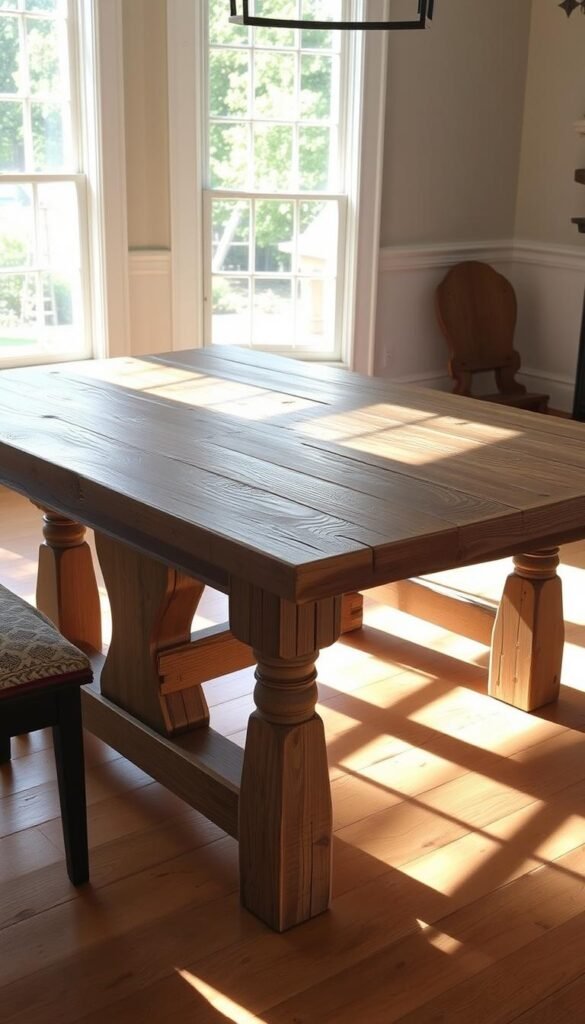
Round vs. Rectangular: Picking the Right Shape
A 42-inch round table fosters intimacy in small spaces, encouraging conversation. For larger rooms, a 96-inch rectangular design zones the area for entertaining. Mindy Gayer’s open-concept spaces often use trestle tables to anchor the layout.
Traffic flow matters—allow 36 inches of clearance around the table for easy movement. Anthropologie’s sculpted pedestal design offers a modern twist, while classic rectangles pair well with wood beams overhead.
Reclaimed Wood vs. Live-Edge: Material Choices
Restoration Hardware’s Salvaged Elm wood dining table showcases grain variations, each scratch telling a story. For durability, white oak resists wear, while reclaimed pine adds rustic wood character.
McGee & Co’s live-edge walnut table pairs an iron base with natural wood edges, celebrating organic flaws. Stabilization techniques—like resin fills—prevent cracking in live-edge pieces.
- For small spaces: Round tables (42″-48″) with pedestal bases save floor space.
- For durability: White oak withstands daily use; reclaimed pine ages gracefully.
- For modern flair: Live-edge slabs with metal bases blend rustic and industrial.
3. Fresh Farmhouse Dining Room Ideas with Simple Updates
Small tweaks to seating and tablescapes can redefine a space without a full overhaul. Designers like Amber Lewis and Jake Arnold prove that mixing textures—like linen slipcovers with velvet accents—adds depth to neutral backdrops.
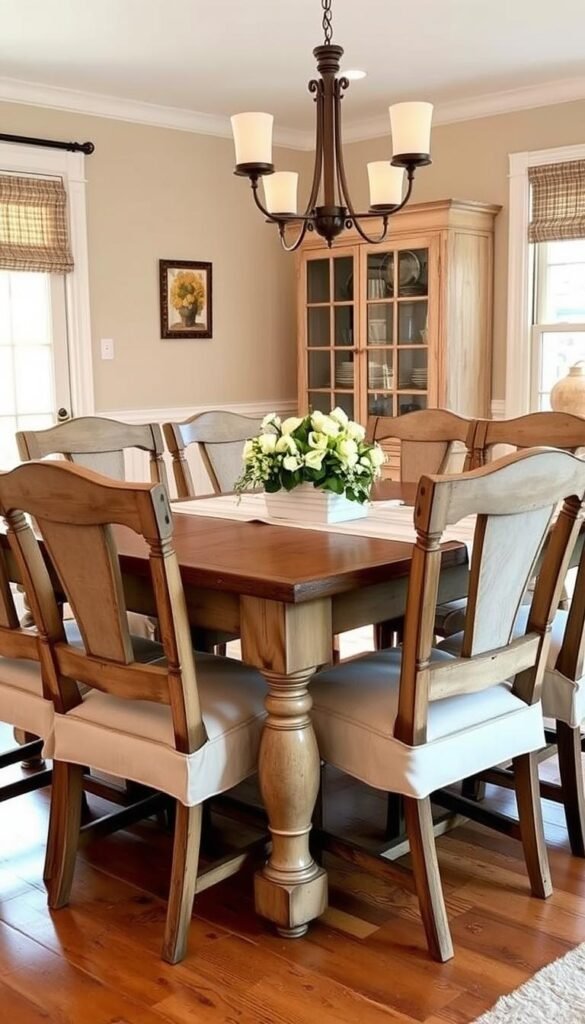
Swap Out Chairs for an Instant Refresh
Bemz slipcovers transform IKEA chairs into linen-clad staples. For bold contrast, paint legs in Farrow & Ball’s Pitch Blue—a trick that adds modern edge to rustic wood frames.
Jake Arnold’s signature style pairs high-back velvet chairs with oak benches. This blend of plush and raw textures balances comfort and design.
Add a Table Runner or Seasonal Centerpiece
World Market’s linen runners anchor tablescapes, while Magnolia wreaths introduce organic shapes. Layer Target’s Threshold placements under Pottery Barn chargers for tactile contrast.
Rotate centerpieces seasonally: faux quince branches in CB2’s ceramic vases for winter, or Trader Joe’s $10 eucalyptus for year-round greenery. These decor swaps keep the dining space feeling dynamic.
- Budget-friendly update: Dip-dye chair legs in muted tones for subtle flair.
- Texture play: Pair woven seats with iron bases for rustic-industrial fusion.
- Quick seasonal shift: Swap runners from burlap (fall) to gauzy linen (summer).
4. Balance Chair Styles for Comfort and Contrast
Chair selection transforms a space from functional to inviting, blending comfort with character. Designers like Amber Lewis showcase how mixed materials—think buttery linen paired with woven rattan—create tactile contrast. The key lies in harmonizing elements while varying heights and textures.
Mixing Upholstered and Woven Chairs
Crinkled velvet swivel chairs from Article make unexpected partners with Crate & Barrel’s Andes dining seats. For rustic modern flair, McGee & Co’s Windsor-back designs complement Serena & Lily’s Cabo stools. Keep seat heights between 17″-19″ for standard 30″ tables.
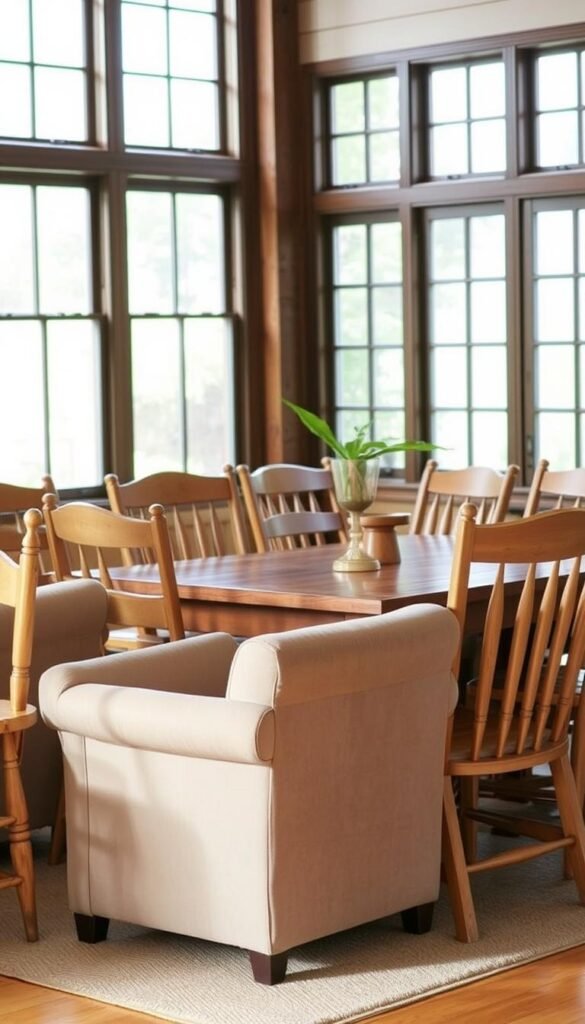
High-Back Chairs for Structured Elegance
Anthropologie’s curved-back designs add drama, while Wayfair’s ladderbacks keep sightlines open. For families, Pottery Barn’s performance fabric resists stains. Vintage Thonet chairs with new upholstery inject heritage charm.
| Chair Style | Best Pairing | Materials |
|---|---|---|
| Velvet Swivel | Oak tables | Iron base + plush seat |
| Woven Rattan | Whitewash wood dining sets | Natural fibers + steel frame |
| High-Back Windsor | Live-edge slabs | Timeworn oak + linen cushion |
- Child-friendly: Stain-resistant fabrics in earthy tones
- Space-saver: Backless benches tuck neatly under tables
- Texture play: Leather straps on ladderbacks contrast with smooth tops
5. Layer Textures for Visual Interest
Texture layering elevates farmhouse style by adding depth and warmth to every surface. From crinkled linen slipcovers to salvaged oak sideboards, tactile contrasts make a space feel curated yet cozy. Designers like Amber Lewis and Mindy Gayer masterfully blend rough and refined materials.
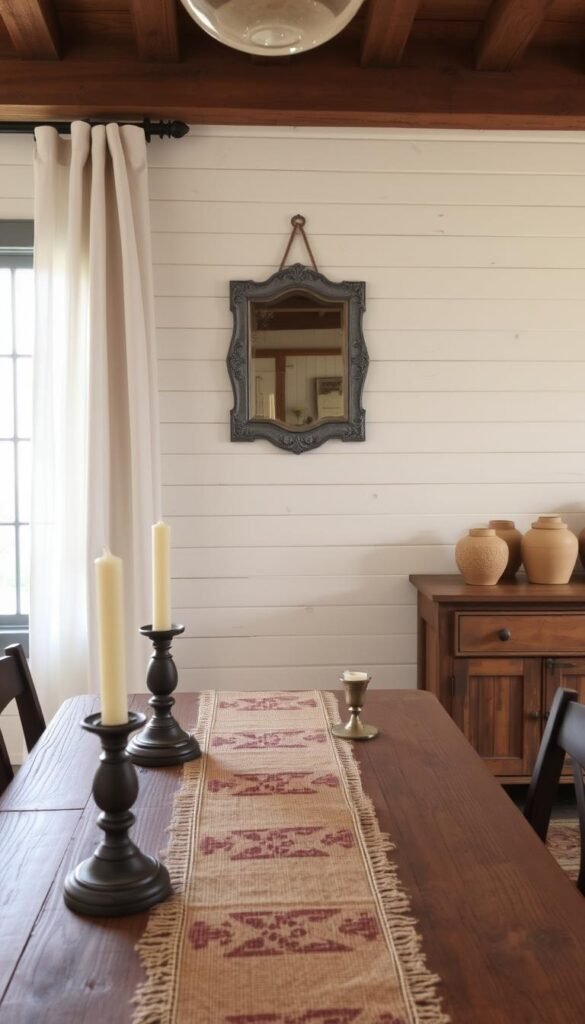
Linen Slipcovers and Rustic Wood Pairings
Bemz’s washable linen covers soften IKEA chairs, while Restoration Hardware’s reclaimed beams add rustic wood grit. For balance, pair a sleek live-edge table with drapey Belgian flax throws. Sunlit patina on natural wood shelves amplifies the organic vibe.
Wicker Baskets and Braided Rugs
Mindy Gayer clusters World Market’s seagrass baskets as walls decor. Layer Ruggable’s jute rug over hardwood floors for underfoot texture. Amber Lewis often tops braided rugs with faux cowhides—a bold mix of elements.
| Texture | Best For | Designer Tip |
|---|---|---|
| Linen | Slipcovers, curtains | Use Crypton fabric for stains |
| Wicker | Storage, wall art | Group in odd numbers |
| Braided jute | Rugs, placemats | Anchor under table legs |
- Quick refresh: Drape faux fur throws on benches for winter.
- Artisan touch: Display Etsy’s hand-thrown pottery on open shelves.
- Lighting texture: Rejuvenation’s rope-wrapped pendants add nautical warmth.
6. Incorporate Statement Lighting
Lighting transforms a space from ordinary to extraordinary, setting the mood and defining the design. The right fixture blends function with artistry—whether it’s a rattan pendant casting woven shadows or an iron chandelier adding industrial edge. Designers like Jake Arnold prove lighting can be both practical and poetic.
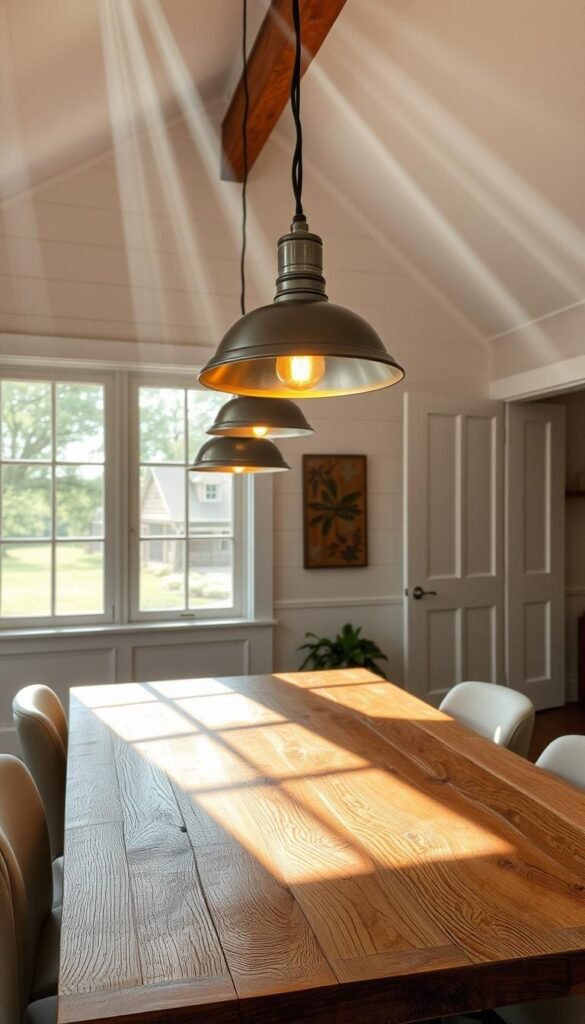
Drum Chandeliers with Organic Texture
McGee & Co’s linen drum fixtures soften rooms with warm wood ceilings. Their 24″-wide size suits 10’x12′ spaces perfectly. For taller wood beams, Visual Comfort’s 36″ rattan design makes a striking focal point.
Layer these with recessed light for adjustable ambiance. Dimmers allow transitions from bright brunches to intimate dinners. The crisscross weave of Serena & Lily’s Belize pendant adds pattern play.
Industrial Pendants for Modern Contrast
Rejuvenation’s cage-style pendant lights introduce metallic notes above rustic tables. Their open frame look maintains airiness in small rooms. Cluster Moooi’s Random pendants at varying heights for drama.
- Renter-friendly update: Schoolhouse’s plug-in sconces need no hardwiring
- Artisan touch: Circa Lighting’s hand-forged iron brings heritage craftsmanship
- Mixed materials: Pair ceramic bases with linen shades for balanced elements
| Fixture Type | Room Size | Height Clearance |
|---|---|---|
| Drum chandelier | Up to 14’x16′ | 30″-34″ above table |
| Industrial pendant | 8’x10′ or smaller | 32″-36″ for visual weight |
| Cluster lights | Open-concept areas | Vary by 6″-8″ per fixture |
Always maintain 30-34 inches between table and pendant light for safe headroom. Electricians recommend LED bulbs in enclosed fixtures to prevent overheating. This balance of safety and style ensures your lighting shines in every way.
7. Define the Space with a Cozy Area Rug
A well-chosen rug anchors the dining area, adding warmth and definition to the space. Designers like Amber Lewis favor textured options—think hand-tufted wool or braided jute—to soften hard floors. Mindy Gayer’s muted stripe rugs prove subtle patterns enhance without overwhelming.
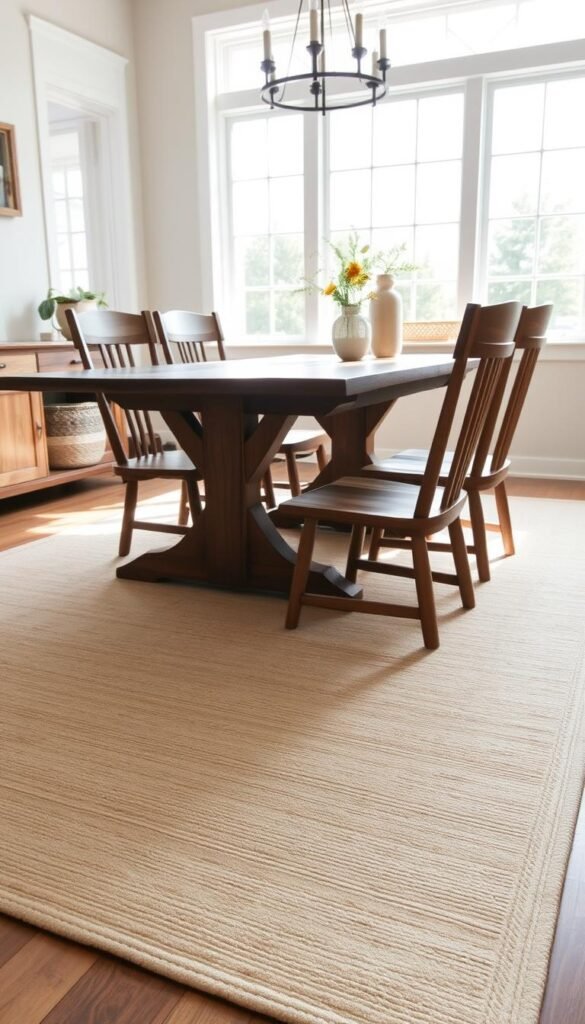
Neutral Rugs with Subtle Patterns
Lorena Canals’ washable wool rugs withstand spills, ideal for families. For layered design, Ruggable’s outdoor styles add spill-proof durability beneath tables. Safavieh’s hand-tufted options introduce organic texture with diamond-patterned dhurries.
Proper Sizing and Non-Slip Pads
Extend rugs 24 inches beyond table edges for visual balance. RugPad USA’s eco-friendly grips protect hardwood while preventing slips. Tuck edges under table legs for stability—a trick McGee & Co. uses in open-concept layouts.
- For small spaces: Loloi’s 5’x8’ rugs zone compact areas without crowding.
- Texture mix: Pair seagrass with linen curtains for tactile contrast.
- Maintenance: Vacuum natural materials weekly to preserve their look.
8. Add a Stone or Brick Accent Wall
Stone and brick walls instantly elevate a space with timeless texture. Whether it’s a fireplace clad in rugged limestone or a slender archway framing a design vignette, these elements add depth and character. Lindye Galloway’s projects prove that even modern interiors benefit from rustic materials.
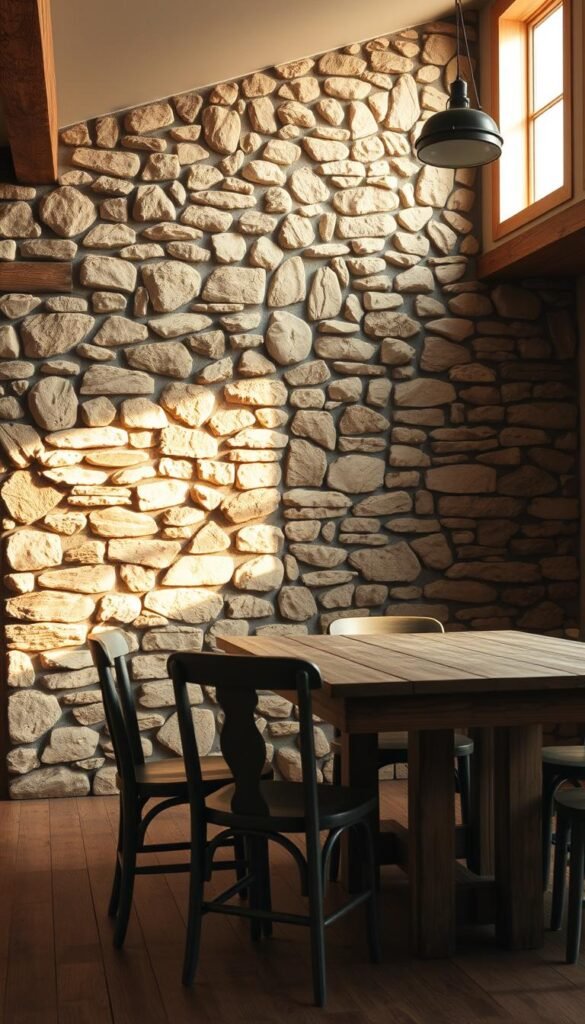
Fireplace Walls for Rustic Charm
Blanc Marine’s signature stone archways turn fireplaces into art. For a budget-friendly alternative, Thin Brick veneer mimics full-depth brick at half the cost. Limewashing—a technique using diluted paint—softens red brick into a muted, modern finish.
Stone Archways as Architectural Focal Points
Pair exposed wood beams with rough-hewn stone for contrast. Electric fireplace inserts offer year-round ambiance without venting hassles. Fireclay Tile’s glazed brick options introduce color while maintaining organic texture.
| Material | Cost per Sq. Ft. | Installation Time |
|---|---|---|
| Natural Stone | $15–$30 | 2–3 days |
| Thin Brick Veneer | $6–$12 | 1 day |
| Limewashed Brick | $8–$15 | 1–2 days |
- Authentic aging: Use mortar smudging techniques to mimic centuries of wear.
- Task lighting: Rejuvenation’s iron sconces embedded in stonework add function.
- Mantel styling: Vintage tools and iron candlesticks enhance the farmhouse style.
9. Integrate Functional Storage Solutions
Smart storage solutions marry form and function, turning clutter into curated charm. Designers like Amy Storm and Amber Lewis showcase how built-ins and open shelving can enhance a farmhouse dining aesthetic while keeping essentials within reach. The secret? Balancing visibility with concealed organization.
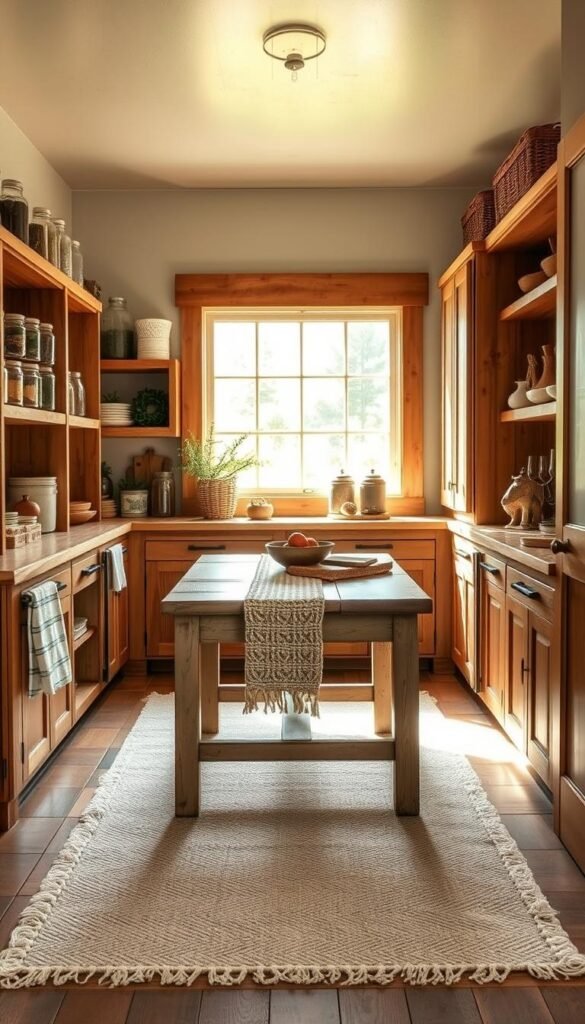
Built-in Cabinets with Open Shelving
Amber Lewis often pairs floor-to-ceiling cabinets with floating shelves. Weathered oak frames contrast with crisp white interiors—a nod to rustic materials meeting modern design. For wine storage, Amy Storm integrates narrow pull-out drawers beside glass-front uppers.
IKEA’s BILLY bookcases gain custom flair with applied molding and beadboard backs. Style them with decor like Mason jars or ironstone pitchers. Hooks beneath shelves create instant mug displays, blending utility with charm.
Storage Benches for Seating and Organization
Banquettes with Rev-A-Shelf inserts hide linens while offering extra seating. Mindy Gayer’s projects often use linen-upholstered benches with lift-up lids—perfect for small spaces. Vintage dressers repurposed as buffet servers add character and drawer space.
| Storage Type | Best For | Materials |
|---|---|---|
| Open Shelving | Displaying decor | Reclaimed wood, iron brackets |
| Built-in Cabinets | Concealing clutter | Painted MDF, oak accents |
| Storage Benches | Small dining areas | Linen upholstery, pine frames |
- Anti-tarnish liners: Protect silverware in drawers with felt padding.
- Dual-purpose furniture: Convert hutches into bar stations with slide-out trays.
- Vertical space: Install wall-mounted racks for cutting boards or woven baskets.
By mixing elements like glass, wood, and iron, storage becomes a seamless part of the dining area’s story—where every piece has a purpose and a place.
10. Style Organic Centerpieces
Organic arrangements transform tables into seasonal canvases, marrying texture and tone. Whether fresh-cut branches or preserved blooms, centerpieces elevate the dining room with nature’s effortless beauty. Designers like Amber Lewis and Jake Arnold showcase how these elements bridge rustic charm and modern design.
Fresh Greenery in Ceramic Planters
Amber Lewis often uses potted olive trees or Trader Joe’s eucalyptus in handmade pottery. The contrast of crinkled leaves against materials like ribbed stoneware adds tactile depth. For year-round vibrancy, preserved boxwood topiaries offer lush greenery without maintenance.
Dried Botanicals for Low-Maintenance Decor
Jake Arnold’s dried lavender bundles or pampas grass introduce earthy elegance. Display them in Anthropologie’s ribbed vases or West Elm’s hammered bowls for sculptural contrast. These decor pieces age gracefully, their muted tones blending with neutral tablescapes.
- Budget-friendly: Float gardenias in thrifted bowls for instant romance.
- Seasonal rotation: Swap citrus-filled dough bowls in winter for spring’s cherry blossoms.
- Artisan touch: Air plant terrariums with moss add whimsy to modern settings.
Whether fresh or dried, centerpieces should complement the room’s look without overwhelming it. The key lies in balancing scale—low arrangements for conversation, tall branches for drama.
11. Curate Minimalist Wall Art
Wall art in farmhouse spaces tells a story through texture and simplicity. Whether it’s a single oversized botanical print or a cluster of vintage clocks, each piece adds depth to the design. JDP Interiors favors gallery walls, while Amber Lewis leans toward bold singular statements—both approaches celebrate the farmhouse style’s warmth.
Botanical Prints and Landscape Scenes
Framed seed packets or Society6’s nature prints bring organic elements indoors. For a curated look, group three varying sizes in weathered oak frames. Amber Lewis often pairs a lone landscape with IKEA’s shadow boxes—proof that less can be more.
Vintage Clocks and Wooden Trays as Accents
Salvaged shutters mounted as shelves showcase cutting boards or ironstone plates. A single antique quilt hung as textile art adds softness to brick walls. These decor choices blend function with nostalgia, a hallmark of modern farmhouse decor.
| Approach | Best For | Key Tip |
|---|---|---|
| Gallery Walls | Large spaces | Use odd-numbered groupings |
| Single Statements | Small rooms | Anchor with oversized art |
| Functional Art | Open shelving | Mix trays and plates for texture |
- Budget-friendly: Frame thrifted book pages or blueprints.
- Seasonal swap: Rotate transferware plates with holiday motifs.
- DIY touch: Stencil botanical designs onto salvaged wood.
For more inspiration on blending rustic and contemporary elements, explore our guide to modern farmhouse decor.
12. Maximize Natural Light
Natural illumination elevates dining areas, creating airy yet intimate atmospheres. Designers like Jake Arnold use sheer curtains to soften sunlight, while Lindye Galloway positions tables near windows to harness daylight. These elements blend functionality with rustic charm.
Sheer Curtains for Soft Illumination
Jake Arnold favors linen sheers—their loose weave diffuses light without blocking views. For UV protection, Solar Shades in neutral tones filter glare while preserving privacy. Hang panels wider than the window frame to maximize sunlight when drawn back.
Positioning Tables Near Windows
Lindye Galloway’s projects often place dining tables within 3 feet of windows. This ensures meals feel sun-dappled even in smaller spaces. Transparent acrylic chairs maintain sightlines, enhancing the look of openness.
- Reflective surfaces: Mirror tiles opposite windows bounce light deeper into rooms.
- Adaptable privacy: Frosted window film obscures views without darkening interiors.
- Playful accents: Crystal prisms cast rainbows when hung near sunny panes.
| Solution | Benefit | Designer Tip |
|---|---|---|
| Sheer Curtains | Diffused glow | Choose linen for texture |
| Window Film | Privacy + light | Matte finish reduces glare |
| Mirror Tiles | Expands space | Place at 45° angles |
Whitewashed wood blinds and strategically placed metallic decor further amplify brightness. The goal? A design that feels both glowing and grounded.
13. Blend Rustic and Modern Elements
Industrial metals meet organic wood grains in this balanced design approach. The magic happens when clean lines of contemporary furniture intersect with the warmth of wood tones. McGee & Co’s signature tables prove this duality—think crinkled steel bases supporting slabs of dark wood with glowing patina.
Metal-Legged Tables with Wood Tops
CB2’s concrete-topped tables gain softness when paired with Windsor chairs in timeworn oak. Jake Arnold often uses this contrast—sleek blackened iron bases under live-edge walnut create instant rustic modern appeal. For smaller spaces, West Elm’s hairpin-legged designs maintain airiness while grounding the look.
Clean-Lined Chairs Paired with Rustic Beams
Overhead, rough-sawn materials like reclaimed barnwood add texture against minimalist seating. Amber Lewis suspends these beams above Restoration Hardware’s leather dining chairs—their buttery upholstery contrasting with the ceiling’s rugged elements. This interplay of refined and rough defines the aesthetic.
- Unexpected pairings: Schoolhouse’s globe pendants cast warm light over barnwood tables
- Hardware harmony: Polished nickel knobs on knotty alder doors blend sheen with grain
- Textural layers: Sheepskins draped on Eames-style chairs soften angular profiles
| Modern Element | Rustic Counterpart | Designer Example |
|---|---|---|
| Concrete tabletop | Reclaimed oak legs | McGee & Co’s Salvage Collection |
| Black iron balusters | White oak staircase | Jake Arnold’s Malibu project |
| Marble counter | Driftwood island base | Amber Lewis’ Napa kitchen |
The key lies in balancing proportions—a hefty farmhouse table needs slender metal chairs, while delicate glassware shines on chunky wood shelves. This tension between materials creates spaces that feel both grounded and fresh.
14. Set a Farmhouse-Inspired Table
A thoughtfully set table becomes the soul of farmhouse gatherings, where every piece tells a story. Amber Lewis demonstrates how stoneware dishes and Tracy Svendsen’s thrifted glassware create eclectic charm. These elements blend practicality with personal history—the hallmark of authentic farmhouse dining.
Layered Linens and Artisanal Dinnerware
Start with Target’s linen napkins as a base for Williams Sonoma’s earthy plates. Heath Ceramics’ hand-thrown stoneware adds organic irregularity—each piece unique like materials from nature. Vintage flatware polished to a soft gleam completes the look.
For centerpieces, reclaimed wood slices become rustic name tags. Grandma’s cake stands elevate pies into decor features. Iron-on herb transfers personalize napkins—think rosemary sprigs pressed into flax cloth.
Thrifted Glassware and Seasonal Accents
Mason jars double as water glasses when paired with striped paper straws. Tracy Svendsen suggests mixing Depression-era goblets with modern tumblers for contrast. Polish family heirloom candlesticks for holiday meals—their patina adding warmth.
- Textural contrast: Rough burlap runners under smooth ceramic plates
- Light play: Tea lights in vintage jelly jars cast flickering patterns
- Seasonal rotation: Swap summer wildflowers for autumn wheat sheaves
Every meal becomes an occasion when the dining table reflects thoughtful style. The key lies in balancing cherished heirlooms with contemporary comforts—a table set for both nostalgia and new memories.
15. Incorporate Warm Wood Tones
Wood’s natural warmth transforms spaces into inviting retreats, grounding modern aesthetics with organic charm. From exposed beams to sleek furniture, its versatility bridges rustic and contemporary design. Brands like Coco & Jack showcase how wood tones elevate floors, while Hoedemaker Pfeiffer blends mid-century modern lines with farmhouse soul.
Ceiling Beams and Hardwood Floors
Whitewashed wood beams add texture without overwhelming a room. For floors, engineered herringbone patterns install seamlessly over concrete. Reclaimed oak or walnut planks age gracefully, their patina deepening with time.
Mid-Century Modern Wood Furniture
Teak sideboards paired with linen drapes merge eras effortlessly. Refinish vintage Drexel dressers as buffets—their clean lines contrast with rustic materials. Floating shelves in walnut anchor open shelving, ideal for displaying stoneware or trailing ivy.
- Contrast is key: Ebony-stained table legs pop against light oak tops.
- Functional art: Butcher block islands sealed with food-safe oils double as prep space.
- Layer textures: Woven rattan chairs beside a live-edge wood dining table.
For more ways to blend wood accents, explore our guide to modern farmhouse decor. The right balance of warm wood elements creates spaces that feel both timeless and fresh.
16. Conclusion
Every meal becomes memorable when the space reflects both comfort and intentional design choices. Start with a neutral base—creamy walls or warm wood tones—then layer in mixed materials like iron and linen. Personal touches, like thrifted glassware or hand-me-down quilts, add soul.
Upgrade gradually. Swap outdated lighting for a woven pendant or test new chairs during a casual dinner party. Always check floor joists before adding hefty tables—safety ensures longevity.
Embrace sustainability by sourcing vintage finds. Rotate decor seasonally: woven baskets in summer, wool throws in winter. As designer Amber Lewis notes, “A well-loved space nurtures both food and fellowship.” Your modern farmhouse journey begins with one thoughtful change.
